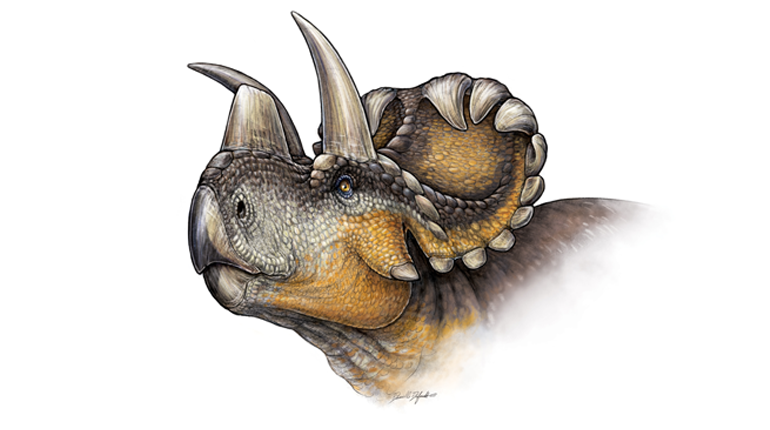
Life reconstruction of Wendiceratops pinhornenis. Credit: Danielle Dufault.
-
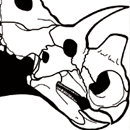 Reconstruction of the skeleton of Wendiceratops pinhornenis Credit: Danielle Dufault
Reconstruction of the skeleton of Wendiceratops pinhornenis Credit: Danielle Dufault -
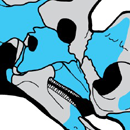 Reconstruction of Wendiceratops pinhornenis skeleton showing the bones that have been found to date in blue. Credit: Danielle Dufault.
Reconstruction of Wendiceratops pinhornenis skeleton showing the bones that have been found to date in blue. Credit: Danielle Dufault. -
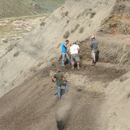 Removing the tons of rock from above the fossil-bearing bonebed layer where the new dinosaur was found (summer 2012). Credit: David Evans
Removing the tons of rock from above the fossil-bearing bonebed layer where the new dinosaur was found (summer 2012). Credit: David Evans -
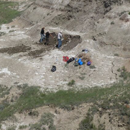 Preparing the site for excavation in the summer of 2013. Credit: David Evans
Preparing the site for excavation in the summer of 2013. Credit: David Evans -
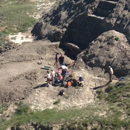 Wendiceratops bonebed quarry during excavations in the summer of 2014. Credit: David Evans
Wendiceratops bonebed quarry during excavations in the summer of 2014. Credit: David Evans -
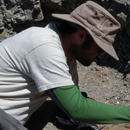 A student digs up bones at the Wendiceratops bonebed quarry. Credit: David Evans
A student digs up bones at the Wendiceratops bonebed quarry. Credit: David Evans -
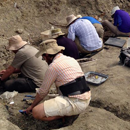 Field crew systematically excavating the Wendiceratops bonebed. Credit: David Evans
Field crew systematically excavating the Wendiceratops bonebed. Credit: David Evans -
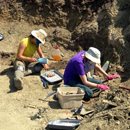 Two University of Toronto undergraduate students digging in the Wendiceratops bonebed. Credit: David Evans
Two University of Toronto undergraduate students digging in the Wendiceratops bonebed. Credit: David Evans -
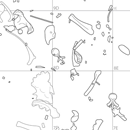 Quarry map of the Wendiceratops bonebed showing the locations of the excavated bones. Credit: David Evans
Quarry map of the Wendiceratops bonebed showing the locations of the excavated bones. Credit: David Evans -
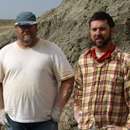 Photograph of Dr. Michael Ryan (left) and Dr. David Evans (right), co-authors of the paper describing Wendiceratops pinhornenis. Credit: Derek Larson
Photograph of Dr. Michael Ryan (left) and Dr. David Evans (right), co-authors of the paper describing Wendiceratops pinhornenis. Credit: Derek Larson -
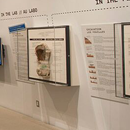 See the New Dino Discovered exhibition for more on the Wendiceratops discovery.
See the New Dino Discovered exhibition for more on the Wendiceratops discovery. -
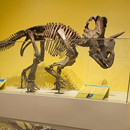 See Wendiceratops on display at the ROM in the New Dino Discovered exhibition.
See Wendiceratops on display at the ROM in the New Dino Discovered exhibition. -
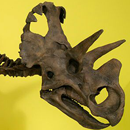 See Wendiceratops on display at the ROM in the New Dino Discovered exhibition.
See Wendiceratops on display at the ROM in the New Dino Discovered exhibition. -
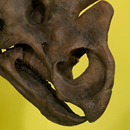 See Wendiceratops on display at the ROM in the New Dino Discovered exhibition.
See Wendiceratops on display at the ROM in the New Dino Discovered exhibition. -
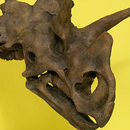 See Wendiceratops on display at the ROM in the New Dino Discovered exhibition.
See Wendiceratops on display at the ROM in the New Dino Discovered exhibition.
Wendiceratops pinhornensis was discovered by acclaimed fossil hunter Wendy Sloboda in southern Alberta in 2010. It lived 79 million years ago, making it one of the oldest named members of the horned dinosaur family that includes Triceratops.
The new find is one of the most spectacularly adorned species in the horned dinosaur group, and it helps scientists understand the early evolution of skull ornamentation in an iconic group of dinosaurs characterized by their horned faces.
The research on Wendiceratops was completed by Dr. David Evans from the Royal Ontario Musem and University of Toronto, and Dr. Michael Ryan from the Cleveland Museum of Natural History. Their research has greatly increased the understanding of the evolution of horned dinosaurs.
Read the Press Release
Name: Wendiceratops pinhornensis
(Pronunciation: WEN-dee-CERE-ah-TOPS PIN-horn-EN-sis)
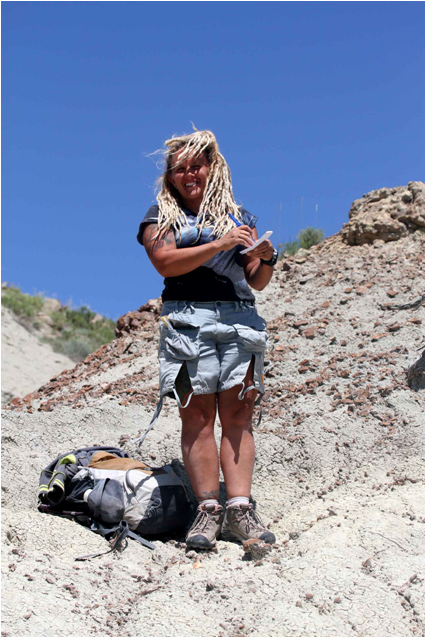
Photograph of Wendy Sloboda, who discovered the site where the bones of the new dinosaur were recovered. Credit: Michael Ryan
Name Meaning: The name Wendiceratops (Wendi + ceratops) means “Wendy’s horned-face”, and celebrates renowned Alberta fossil hunter Wendy Sloboda, who discovered the site in 2010. This is a well-deserved honour for Ms. Sloboda, who has discovered hundreds of important fossils in the last three decades, including several new species. The species name, or second name, references the Pinhorn Provincial Grazing Reserve, where the bones were found.
Age: Late Cretaceous (~79 million years ago)
Where It's Found: County of 40 Mile, Pinhorn Provincial Grazing Reserve, southern Alberta, Canada.
Geologic Formation: Oldman Formation (lower unit)
Classification: Dinosauria – Ornithischia – Ceratopsia – Ceratopsidae - Centrosaurinae
Description: Wendiceratops is a relative of the famous Triceratops. Like its famous cousin, it has a rhino-like body and it walked around on four legs. Wendiceratops was approximately 6 meters (20 feet) long and weighed more than a ton. Wendiceratops had a fantastically adorned skull, particularly for an early member of the horned dinosaur family. Its most distinctive feature is a series of forward-projecting hook-like horns along the margin of its wide, shield-like frill that projects from the back of its skull. The new find challenges other recent discoveries for the most spectacular skull ornamentation in the horned dinosaur group. It was a herbivore, and would crop low-lying plants with a parrot-like beak, and slice them up with dozens of leaf-shaped teeth.
Significance: The recognition of Wendiceratops affirms a high diversity of ceratopsids likely associated with a rapid evolutionary radiation of the group. It also helps document high faunal turnover rates of ceratopsids early in their evolution, coupled with some degree of ecological niche partitioning during this time. The horn on the nose is the most interesting feature of Wendiceratops. Although the nasal bone is represented by fragmentary specimens and its shape is unknown, it is clear that it supported a prominent, upright nasal horncore. This represents the earliest documented occurrence of a tall nose horn in Ceratopsia. Not only does it tell scientists when the nose horn evolved, the research reveals that an enlarged conical nasal horn arose at least twice in the horned dinosaur family, once the short-frilled Centrosaurinae group that includes Wendiceratops, and again in the long-frilled Chasmosaurinae group which includes Triceratops. This surprising, since a nose horn has been generally thought to characterize Ceratopsidae, and be present in their common ancestor.
Digging Up the Dinosaur: Wendiceratops pinhornensis, is described from over 200 bones collected from the remains of at least four individuals (three adults and one juvenile) from a bonebed in the Oldman Formation of southern Alberta, near the border with Montana, USA. The bonebed is located at the bottom of an 20 m (60 ft) cliff-like badlands bluff, which required weeks of back-breaking work to remove before the majority of the bones could be excavated. It took 4 years to dig up the bones collected so far, and work continues at the site. This dinosaur the latest in a series of new finds being made by Evans and Ryan as part of their Southern Alberta Dinosaur Project, which is designed to fill in gaps in our knowledge of Late Cretaceous dinosaurs and study their evolution.
Where to See It: A full skeleton reconstruction is on display in the New Dino Discovered exhibit at the Royal Ontario Museum. The dig that uncovered the remains of Wendiceratops was featured on the HISTORY Channel documentary series Dino Hunt Canada. More information at www.dinohuntcanada.history.ca/
Open Access Publication: David C. Evans and Michael J. Ryan, “Cranial Anatomy of Wendiceratops pinhornensis gen. et sp. nov., A Centrosaurine Ceratopsid from the Oldman Formation (Campanian), Alberta, Canada, and the Evolution of Ceratopsid Nasal Ornamentation.” PLoS One. DOI: 10.1371/journal.pone.0130007 http://journals.plos.org/plosone/article?id=10.1371/journal.pone.0130007
Blog entries related to the discovery of Wendiceratops:
Southern Alberta Dinosaur Project 2011, June 28 - July 2, 2011
Southern Alberta Dinosaur Project 2011 - Found a skull!, July 3 - 5, 2011
Southern Alberta Dinosaur Project 2011 - Visitors!, July 6 - 8, 2011
Southern Alberta Dinosaur Project 2011 - Prospecting for new dinos!, July 10 - 12, 2011
Southern Alberta Dinosaur Project 2011 - Cherry on top, July 13 - 14, 2011
Southern Alberta Dinosaur Project 2012, August 14, 2012
